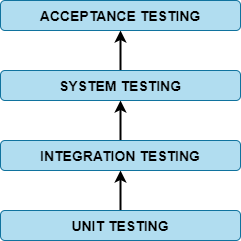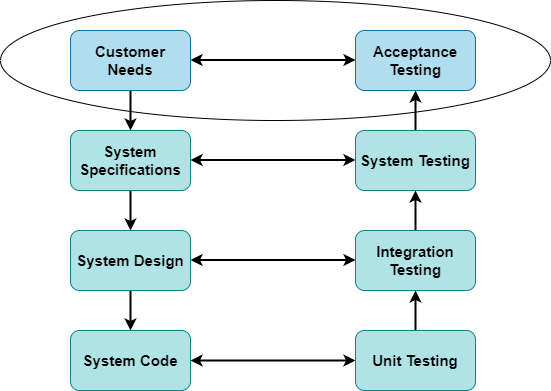
The development of software requires different methodologies, concepts, and guides to be followed throughout its life cycle. One organization must have a development and testing strategy defined early before the initial work on a product specified by the customer. The requirements are some from of source of truth for one development team and therefore, that form of a document specification needs to be handled and maintained accordingly. Since the delivery of software to the customer is the most important task, we must ensure that all the product functionalities comply with what the customer actually wanted, e.g. the requirements.
So, the system must satisfy all the requirements from the customer and all flows and actions that one end user would perform. In order to achieve that the product must be tested in the 4 main testing levels differently.
Unit testing, integration testing, system testing, and integration system testing are some of the main testing levels one software must go through to verify the product. But as a final step, the one that validates if the product is fit to use is called acceptance testing.
In this post, we will go through what is acceptance testing, why it is important, how t is performed, and what are some of the types of acceptance testing.
What is Acceptance Testing?

Acceptance testing is a testing method where one system is being tested to validate that it meets the business requirements, e.g. it is tested for customer acceptability. The main purpose is to evaluate if the required criteria set by the customer and end-users are met and it is fit to be used. This is the last phase of the test levels and it is performed once System Testing is fully executed and shown to be successfully passed.
An environment is created which is identical to the production environment. That would serve as a place where the testing would occur before releasing. This is not the preferred stage where any bug or change request should occur as it would be very expensive to fix given the deadline set by the customer.
Why it is important?
Performing this type of test as a last test level comes with many benefits:
- Validates that the product is ready to be used by the end-users
- Reduces the risk of potential issues found in a production
- Users gain initial knowledge and understanding by testing the product before it goes live
- It takes 10-15% of the team effort to perform it but it can help discover many potential not wanted issues
- Manual testing is preferred since it is the last step, hence, a human must validate it rather than automated tests
How is it is performed?

Although this type of test can result in many organizational benefits, it has some challenges and requires some planning to be done before performing it.
Many system attributes must be addressed in acceptance testing. From functional aspect (how the system behaves and what should do), usability aspect (is the system usable enough for all users) and performance aspect (is the system fast enough to respond quickly after user action is performed), to the installable aspect (can the system be installed easily and correctly) and scalable aspect (how the system responds if we scale up or scale down the amount of data handled, traffic volume, transaction flow, etc.).
An acceptance test plan must be written, maintained and followed. The plan should include:
- Introduction and a quick summary
- Acceptance category
- Environment information
- Test cases to be performed and their IDs
- Testing objective, procedure, and schedule
- Additional testing resources
After the testing is executed the customer can approve the system, accept the system but after some modifications are addressed or if any change requests have been fixed, or can decline the system due to some major functionality flaws. This is the main reason why testing needs to be shifted-left in the SDLC.
In order for us to have a successful acceptance testing, we must ensure that we set proper expectations between testers at the beginning of the test, make sure that end-users perform the testing since they have a greater knowledge of the product workings, arrange any potential meetings to conclude if the phase is successfully passed or any additional changes need to be made, prioritize flows, defects, and important functionalities.
What are the main types of acceptance testing?
Contract Acceptance Testing
CAT is a test that is performed against a predefined contract. This means that all the criteria and requirement specifications need to be covered with testing and shown to be passed. The contract (usually called Service Level Agreement) argues that full payment to the IT organization will be made until all of the system aspects be tested and be shown that they working as expected. This can include technical and non-functional characteristics of the system.
Operational Acceptance Testing
OAT focuses on the non-functional characteristics of the software including compatibility, maintainability, recovery, etc. After performing this type of test we conclude that the system has the level of operational readiness prior to release.
Regulations Acceptance Testing
RAT is a test that covers the rules and regulations aspects of the software. It is usually defined by the government of a country where the software is released. Since the different country has different rules and regulations, the software must accommodate all the requests in order to be released.
Alpha & Beta Testing
Carried out by the employed testers in the organization, alpha testing is a form of acceptance testing that tries to identify any potential issues or bugs before going live. Beta testing is a test performed by real users and it is a form of acceptance testing. Since it is the final test before shipping the product to the customers, feedback collected from the users is more than welcomed which can address any potential bugs or overall UI improvement.
Business Acceptance Testing
Due to the constantly changing markets, technical improvements, and challenges, BAT needs to occur. BAT mainly covers the profit from the released software, even though it can be challenging concerning the fact that many external factors can affect the software, hence the business profit at the end of delivery.
User Acceptance Testing
If the user tests the software and determines that it is fit to use, then, that is called UAT. Also called end-user testing, which focuses on the requirements that end users are using quite often. It can be performed in a production-like environment with production-identical data.
Conclusion
Acceptance testing is surely the most important phase since it is a final stage, a final bridge between something that is in development and test and something that needs to be used daily by the end-users. The way how we perform this type of testing must be precise and followed by some guides and steps to fulfill customer satisfaction.
Share This Post
Latest Posts
- Test Analyst’s Responsibilities in Risk-Based Testing
- Crucial Aspects Of Superior Test Code Quality
- Streamline Your Cucumber BDD Tests with Gherkin Lint: A Comprehensive Guide
- How to Test Authentication and Authorization with Confidence + Best Tips
- Exploring the Three Scrum Artifacts: Grasping Their Essence and Effective Utilization












